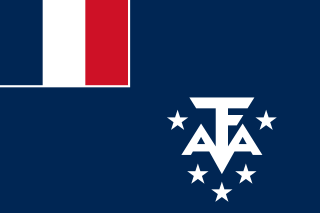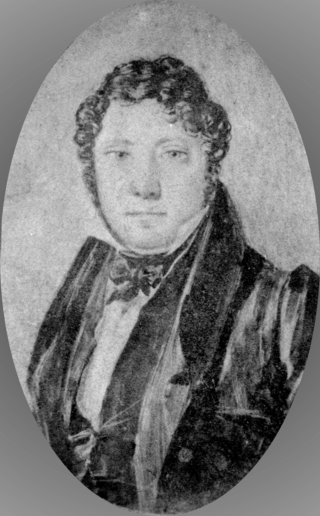
The Crozet Islands are a sub-Antarctic archipelago of small islands in the southern Indian Ocean. They form one of the five administrative districts of the French Southern and Antarctic Lands.

HMS Charybdis was a Royal Navy Cruizer-class brig-sloop built by Mark Richards and John Davidson at Hythe, and launched in 1809. She captured two American prizes during the War of 1812 before she was laid up in 1815 and sold in 1819. She apparently then became the whaler Greenwich, which made three voyages for Samuel Enderby & Sons and one for Daniel Bennett & Son. She was wrecked in the Seychelles in 1833 on her fourth whaling voyage.

Captain John Dibbs was a master mariner prominent during 1822–1835 in the seas around the colony of New South Wales, New Zealand and the Society Islands. Dibbs was master of the colonial schooner Endeavour 1822–1824, the brig Haweis 1824–1827 and the barque Lady Blackwood 1827–1834. He is credited as the European discoverer of Rarotonga and several other islands. Most of his voyages involved the transporting of missionaries, trade, whaling and seal hunting. He was believed for over 170 years to have disappeared at sea in 1835. He was the father of Sir George Dibbs, a pre-Federation Australian politician, Sir Thomas Dibbs, an Australian banker, and John Campbell Dibbs, a successful Sydney businessman.
King George was built on the Thames in 1783 as a West Indiaman. From 1817 she made four voyages as a whaler in the British southern whale fishery. She was condemned at Guayaquil in 1824 on her fifth.
Emma was a merchant vessel launched at Calcutta in 1809 that in 1810 served as a government armed ship in the British invasion of Île de France. In 1811 she sailed to England where she was sold. She then became a transport and later a whaler. Between 1815 and 1853 she made 11 whaling voyages. She was then sold and became a merchantman on the England-Australia run. Between 1851 and 1853 she made one more whaling voyage to the South Seas fisheries. She then returned to the England-Australia trade. In 1857 her home port became Hull, and she became a Greenland whaler, though that role may have begun as early as 1855. She was converted in 1864 to a screw steamer but was lost in April while seal hunting.
Rambler was launched in America in 1812. The British captured her in 1813 as she was returning to America from Manila. She then briefly became a West Indiaman. In 1815 she became a whaler in the Southern Fishery. She made four complete whaling voyages and was wrecked on her fifth.
Salisbury was launched c.1814 in the Brazils almost certainly under another name and was possibly a prize. She was possibly captured by the British or sold to British owners in 1815. She made one voyage seal hunting in 1820 and transported settlers to South Africa in 1821. She was lost in 1827.
Cicero was launched at Sunderland in 1796 and initially sailed as a West Indiaman. She was briefly captured in 1799 in a single-ship action with a French privateer. Later, she went whale hunting both in the northern whale fishery (1803-1808), and the southern whale fishery (1816-1823). She capsized at Limerick in September 1832 and was condemned there.
Lord Wellington was launched in 1810 at Rochester, or equally, Chatham, as a West Indiaman. She made at least one voyage to India under a license from the British East India Company (EIC). She then made a voyage to New South Wales transporting female convicts from England and Ireland. She was lost in December 1822 off Denmark while sailing from Saint Petersburg to London.
Adrian was launched in 1819 at Newcastle upon Tyne. She initially sailed between London and Canada but then in 1822 she started sailing east of the Cape of Good Hope under a license from the British East India Company. She made voyages to Bengal and Batavia. In between, she transported convicts to New South Wales. She foundered in 1833.

Hermes was built in Quebec in 1811. She traded widely before she made two voyages as a whaler to the British Southern Whale Fishery. She was wrecked in 1822 during the second voyage.
Regalia was launched at Sunderland in 1811. In 1819 she made a voyage to Calcutta, sailing under a license from the British East India Company (EIC). She also sailed to New South Wales and Van Diemen's Land. From Sydney she engaged in several sealing hunting voyages to the waters around Macquarie Island. In 1826 she transported convicts from Dublin to New South Wales. From 1831 until 1852, when she was wrecked at Davis Strait, Regalia was a whaler in the northern whale fishery.
Sesostris was launched at Hull in 1818. She traded with India, the Baltic, and Russia, carried troops for a Chilean military expedition against Peru, and transported convicts to New South Wales. She was broken up in 1843.

Jane was an American vessel launched in 1810 or 1812 and taken in prize, first appearing in British registers in 1818. She then became a whaler. Under the command of Captain James Weddell she explored the area around the South Shetland Islands and in 1823 reached the southernmost point ever reached until then. From about 1825 on she traded generally as a merchantman until she was condemned in 1829.
Comet was launched in 1791 at Rotherhithe. At the outbreak of war with France, she briefly became a privateer before the British East India Company (EIC) chartered her for one voyage to bring back sugar, saltpeter, and other goods from Bengal. Between 1812 and 1821 she made three voyages as a whaler in the British southern whale fishery. Then between 1823 and 1840 she became a whaler based in Hull, whaling in the northern whale fishery. She returned to trade in 1841 and was lost on 1 December 1843 homeward bound from Quebec.
Emperor Alexander was launched at Sunderland in 1814. She traded widely during which time she suffered some misfortunes, being plundered once and grounding once. In 1823 she carried settlers from Tobermory, Mull, to Quebec. She was wrecked in November 1832.
Caroline was launched at Philadelphia in 1800. She was taken in prize. New owners retained her name and she appeared in British records from 1813. From 1820 on she was based at Hobart in Van Diemen's Land. From there she sailed to and from Port Jackson and on seal hunting voyages to Macquarie Island. She departed on a sealing voyage in November 1824 and wrecked at Macquarie Island on 17 March 1825; her crew were rescued some five months later.
Star was built in Calcutta in 1800. Between 1803 and 1811 she made three seal hunting voyages. From 1812 she sailed as a merchantman until she was wrecked on 18 December 1829 on a voyage to Jamaica.
Susanna Ann. was a smack launched at Bridport or Cowes in 1814, almost surely under another name. Between 1823 and 1833 she made six voyages as a whaler and sealer in the British southern whale fishery. From around 1834 on she traded with Africa, and then in 1838 she sailed to New South Wales (NSW). She moved her registry to NSW and traded between east coast Australian ports and with New Zealand until she was wrecked on 20 March 1847.
Zephyr was a vessel built in the United States that the Royal Navy captured in late 1813. Between 1814 and 1840, when she was lost, she made eight voyages as a whaler in the southern whale fishery.




